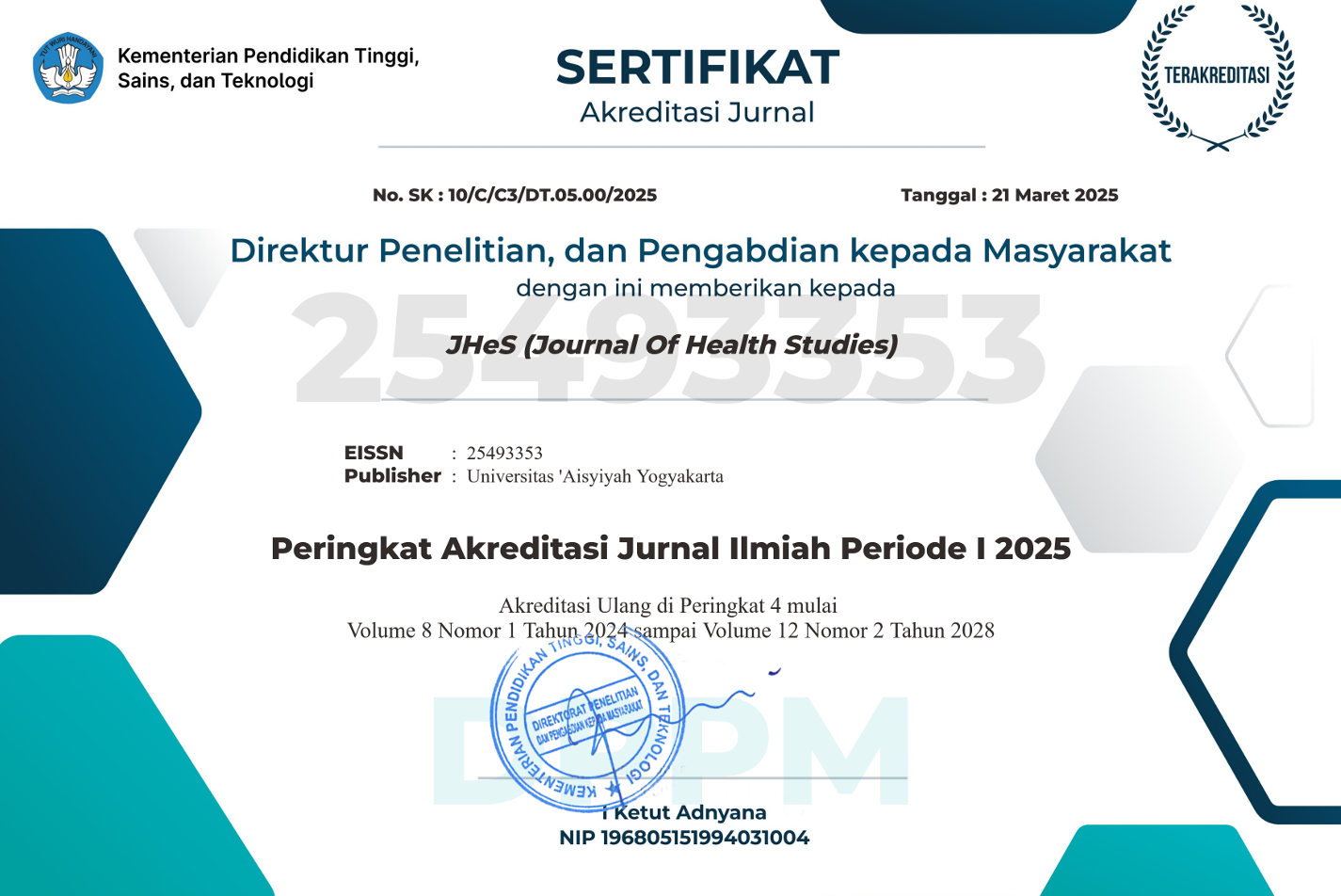Usia, Status Gizi, dan Berat Badan Anak Sebagai Faktor Determinan dalam Estimasi Porsi Makan oleh Ibu
DOI:
https://doi.org/10.31101/jhes.1141Abstract views 1443 times
Keywords:
umur, status gizi, berat badan, porsi balitaAbstract
Downloads
References
Adamo, K. B., & Brett, K. E. (2014). Parental Perceptions and Childhood Dietary Quality. Maternal and Child Health Journal, 18(4), 978–995. https://doi.org/10.1007/s10995-013-1326-6
Basiotis, P. P., Lino, M., & Dinkins, J. M. (2002). Consumption of food group servings: people’s perceptions vs. reality. (Insight 20: October 2000). Family Economics and Nutrition Review, 14(1), 67–70.
https://go.gale.com/ps/anonymous?id=GALE%7CA90529463&sid=googleScholar&v=2.1&it=r&linkaccess=abs&issn=10859985&p=AONE&sw=w
Benton, D. (2015). Portion size: what we know and what we need to know. Critical Reviews in Food Science and Nutrition, 55(7), 988–1004.
https://doi.org/10.1080/10408398.2012.679980
Bergmeier, H., Skouteris, H., & Hetherington, M. (2015). Systematic research review of observational approaches used to evaluate mother-child mealtime interactions during preschool years. The American Journal of Clinical Nutrition, 101(1), 7–15. https://doi.org/10.3945/ajcn.114.092114
Birch, L. ., Fisher, J. ., Grimm-Thomas, K., Markey, C. ., Sawyer, R., & Johnson, S. . (2001). Confirmatory factor analysis of the Child Feeding Questionnaire: a measure of parental attitudes, beliefs and practices about child feeding and obesity proneness. Appetite, 36(3), 201–210. https://doi.org/10.1006/appe.2001.0398
Croker, H., Sweetman, C., & Cooke, L. (2009). Mothers’ views on portion sizes for children. Journal of Human Nutrition and Dietetics, 22(5), 437–443.
https://doi.org/10.1111/j.1365-277X.2009.00969.
Dhingra, P., Sazawal, S., Menon, V. P., Dhingra, U., & Black, R. E. (2007). Validation of visual estimation of portion size consumed as a method for estimating food intake by young Indian children. Journal of Health, Population and Nutrition, 25(1), 112–115.
Fisher, J. O., Goran, M. I., Rowe, S., & Hetherington, M. M. (2015). Forefronts in portion size. An overview and synthesis of a roundtable discussion. Appetite, 88, 1–4. https://doi.org/10.1016/j.appet.2014.11.025
Fisher, Jennifer O., & Kral, T. V. E. (2008). Super-size me: Portion size effects on young children’s eating. Physiology and Behavior, 94(1), 39–47.
https://doi.org/10.1016/j.physbeh.2007.11.015
Foster, E., Hawkins, A., Barton, K. L., Stamp, E., Matthews, J. N. S., & Adamson, A. J. (2017). Development of food photographs for use with children aged 18 months to 16 years: Comparison against weighed food diaries-The Young Person’s Food Atlas (UK). PLoS ONE, 12(2), 1–18. https://doi.org/10.1371/journal.pone.0169084
Gerakan Kesehatan Ibu dan Anak. (2017). Isi Piringku. Gerakan Kesehatan Ibu Dan Anak. https://doi.org/10.1192/bjp.112.483.211-a
Hetherington, M. M., Cecil, J. E., Jackson, D. M., & Schwartz, C. (2011). Feeding infants and young children. From guidelines to practice. Appetite, 57(3), 791–795.
https://doi.org/10.1016/j.appet.2011.07.005
Indonesia, K. K. R. (2016). Pemantauan Status Gizi Dan Indikator Kinerja Gizi.
Johnson, S. L., Hughes, S. O., Cui, X., Li, X., Allison, D. B., Liu, Y., Goodell, L. S., Nicklas, T., Power, T. G., & Vollrath, K. (2014). Portion sizes for children are predicted by parental characteristics and the amounts parents serve themselves. The American Journal of Clinical Nutrition, 99(4), 763–770. https://doi.org/10.3945/ajcn.113.078311
Kairey, L., Matvienko-Sikar, K., Kelly, C., McKinley, M. C., O’Connor, E. M., Kearney, P. M., Woodside, J. V., & Harrington, J. M. (2018). Plating up appropriate portion sizes for children: a systematic review of parental food and beverage portioning practices. Obesity Reviews, 19(12), 1667–1678. https://doi.org/10.1111/obr.12727
Kementerian Kesehatan RI. (2014a). Buku Foto Makanan.
Kementerian Kesehatan RI. (2014b). Panduan Fasilitator Modul Pelatihan Konseling Pemberian Makan Bayi dan Anak. 17.
Kesuma, A., Novayelinda, R., & Sabrian, F. (2015). Faktor-faktor yang berhubungan dengan perilaku kesulitan makan anak prasekolah. Jurnal Online Mahasiswa, 2(2), 953–961.
Nissinen, K., Korkalo, L., Vepsäläinen, H., Mäkiranta, P., Koivusilta, L., Roos, E., & Erkkola, M. (2018). Accuracy in the estimation of children’s food portion sizes against a food picture book by parents and early educators. Journal of Nutritional Science, 7, e35. https://doi.org/10.1017/jns.2018.26
Nuranitha, R. (2013). Hubungan Tingkat Pengetahuan Ibu Tentang Makanan Pendamping ASI (MP-ASI), Umur Pertama Pemberian Dan Kesesuaian Porsi MP-ASI Dengan Status Gizi Bayi Umur 7-12 Bulan Di Kecamatan Jatipuro Kabupaten Karangayar. Universitas Muhammadiyah Surakarta.
Onis, M. De, Borghi, E., Arimond, M., Webb, P., Croft, T., Saha, K., De-regil, L. M., Thuita, F., Heidkamp, R., Krasevec, J., Hayashi, C., & Flores-ayala, R. (2018). Prevalence thresholds for wasting , overweight and stunting in children under 5 years. Public Health Nutrition. 4, 1–5. https://doi.org/10.1017/S1368980018002434
Peter Herman, C., Polivy, J., Pliner, P., & Vartanian, L. R. (2015). Mechanisms underlying the portion-size effect. Physiology and Behavior, 144, 129–136.
https://doi.org/10.1016/j.physbeh.2015.03.025
Potter, C., Ferriday, D., Griggs, R. L., Hamilton-Shield, J. P., Rogers, P. J., & Brunstrom, J. M. (2018). Parental beliefs about portion size, not children’s own beliefs, predict child BMI. Pediatric Obesity, 13(4), 232–238. https://doi.org/10.1111/ijpo.12218
Rolls, B. J., Roe, L. S., & Meengs, J. S. (2006). Larger portion sizes lead to a sustained increase in energy intake over 2 days. Journal of the American Dietetic Association. https://doi.org/10.1016/j.jada.2006.01.014
Ueland, Ø., Cardello, A. V., Merrill, E. P., & Lesher, L. L. (2009). Effect of Portion Size Information on Food Intake. Journal of the American Dietetic Association, 109(1), 124–127. https://doi.org/10.1016/j.jada.2008.10.002
Vaughn, A. E., Tabak, R. G., Bryant, M. J., & Ward, D. S. (2013). Measuring parent food practices: a systematic review of existing measures and examination of instruments. International Journal of Behavioral Nutrition and Physical Activity, 10(1), 61. https://doi.org/10.1186/1479-5868-10-61
WHO Multicentre Growth Reference Study Group. (2006). WHO Child Growth Standards based on length/height, weight and age. Acta Paediatrica (Oslo, Norway : 1992). Supplement, 450, 76–85. http://www.ncbi.nlm.nih.gov/pubmed/16817681
Wilkinson, L. L., Hinton, E. C., Fay, S. H., Ferriday, D., Rogers, P. J., & Brunstrom, J. M. (2012). Computer-based assessments of expected satiety predict behavioural measures of portion-size selection and food intake. Appetite, 59(3), 933–938. https://doi.org/10.1016/j.appet.2012.09.007
Downloads
Published
Issue
Section
License
With the receipt of the article by the Journal of Health Studies Editorial Board and the decision to be published, then the copyright regarding the article will be diverted to Journal of Health Studies. Universitas 'Aisyiyah Yogyakarta as the publisher of Journal of Health Studies hold the copyright regarding all the published articles in this journal.
Journal of Health Studies is licensed under a Creative Commons Attribution-ShareAlike 4.0 International License.













